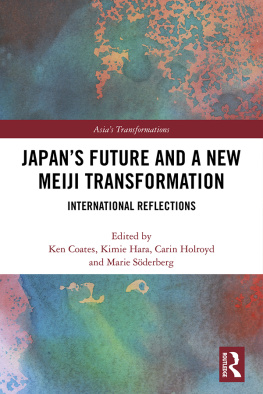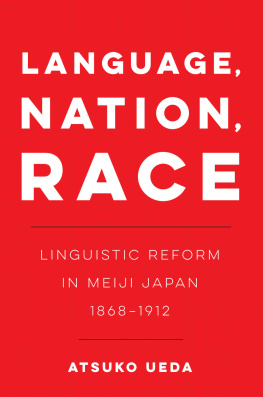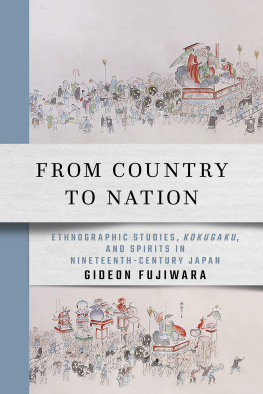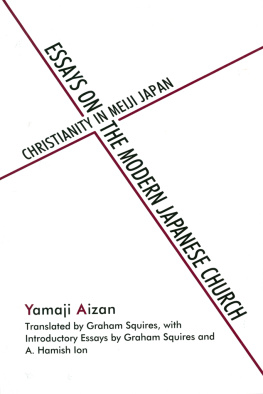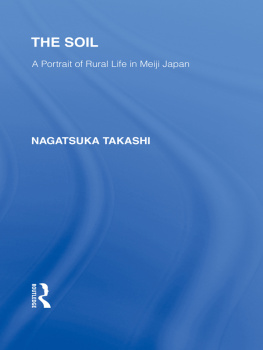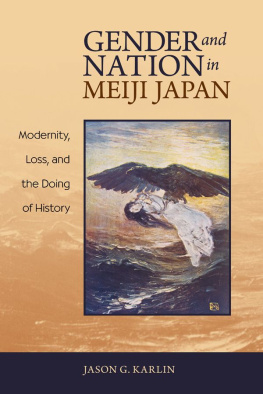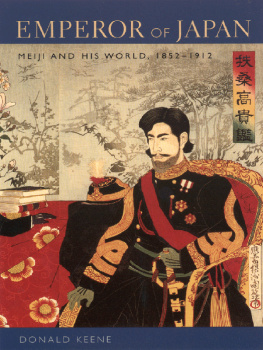ACKNOWLEDGMENTS
I owe a fantastic amount of thanks to many folks. Let me first acknowledge the most distant and least obvious. Friends and common folks in Japan who have provided me tangible and intangible forms of support are too many to cite, but a few do merit special recognition. Unsung heroes of the everyday grind, Ms. Komugai of the Tno City Museum and Mr. Murata of the library and archives at Ty University displayed rare kindness in aiding me to gather research materials. I must also, in spite of our disputes over theory and methodology, give credit to Hara-shida Minoru, ex-restaurateur and freelance scholar, for pointing me several years ago to sources that were the seed of my masters thesis and eventually blossomed into the dissertation on which this book is based. Although they would hardly believe it judging by my constant bickering and complaints, the faculty of the Inter-University Center for Japanese Language Studies earned my appreciation for their unflagging efforts to cut diamonds from the roughest of rocks. The friendship extended to me there by Tateoka Yk, Aoki Sichi, and Kishida Rie made an intensive program less tense. Yko in particular has been a much-cherished friend, and I will be ever grateful to her and her husband Yasuo for putting me up (and putting up -with me) in their home during one research trip.
The Mellon Fellowship in the Humanities that I received from the Woodrow Wilson National Fellowship Foundation and subsequent funding from the University of Chicago Humanities Division allowed me to complete the initial research for this book in relatively swift time with relatively little stress while a graduate student from 1985 to 1992. With a research fellowship from the University of Chicagos Center for East Asian Studies (and the Tateokas hospitality) I was also able to carry out crucial research in Japan in autumn 1990.
All of the funding, research help, and language training in the world, however, would have been all for nought without the guidance and inspiration from the members of my thesis committee at the University of Chicago. Harry Harootunian, who first suggested to me the complexity and importance of questions of the folk in modern Japanese history, has never lagged in showing genuine enthusiasm and zeal for my project. If only a fraction of his intellectual energy remains with me I will consider myself well stoked for many years to come. Tetsuo Najita shares with him an ability gained only by experience to relate the particulars of any research to larger political, social, and cultural formations. Their analytical and critical attention as well as their open minds are what made a topic such as mine even thinkable. I only wish William Sibleys uncanny sensitivity to nuances of literary language Japanese or otherwise would somehow magically rub off on me. I thank him for introducing me to the eerie pleasure of Izumi Kykas prose and for getting me through the more tortuous passages. His wit and pleasant company often made more endurable the more tortuous passages of graduate school as well. I also thank Norma Field not only for teaching me something of classical Japanese language and literature but also for her always amicable and vibrant conversations on all topics great and small.
Above and beyond intellectual guidance, I owe all of my mentors heartfelt gratitude for the concern they have shown for me as a fellow human being plugging along in life. Since the first (and only!) history course I ever took from him in 1980 to the present, Hal Drake of the University of California at Santa Barbara has been a valued adviser and friend and whether he approves of it or not, he is my role model for teaching. I would not be studying history today if it werent for him, and I would not be studying Japanese history if it werent for his then colleague at UCSB, Henry D. Smith II. Henrys undergraduate courses captured my interest in Japan, and the rest is history. His continuing concern and overall good-naturedness I will always hold in high esteem.
I must also credit Henrys fellow historian of Japan at Columbia University, Carol Gluck, for urging me to get this book out and for recommending the Studies of the East Asian Institute at Columbia University as a vehicle for that task. The Institute Publications Director Madge Huntington, in conjunction with Duke University Press Executive Editor J. Reynolds Smith and his Senior Editorial Assistant Sharon P. Torian, have made the publication process much more bearable than I imagined. To begin with, they secured three conscientious reviewers who characterized and clarified my project better than I ever could. The constructive comments and overwhelming encouragement I received from them eased some of the anxieties accompanying authorship. Stefan Tanakas thorough pro bono reading of an early draft, too, worked wonders to help frame the project and bolster my confidence.
I could go on about the priceless intellectual stimulation that my peers from the Chicago days have provided, but I wont, since what must be acknowledged as having been at least as important is their down-to-earth camaraderie without which this life of the mind would be a very paltry thing indeed. That means all those things we did together which reminded us that there is also a life of the body, and we needed a lot of reminding. The we in this case includes Bob Adams, Noriko Aso, Susan Burns, Alan Christy, Yoshikuni Igarashi, Tom LaMarre, Tom Looser, Fukiko Ogisu, Walter Skya, and Kentar Tomio. Once I crossed to the other side of the podium with my first job at Lewis and Clark College and then in the Department of History at the University of Delaware, I found invaluable collegiality and encouragement from persons too numerous to name, but you know who you are.
Finally, to the closest and most obvious: my parents, whose unwavering faith in all of my endeavors has been my secret catalyst; and my wife, Ruth Rogaski, whose spirited intellect, good humor, loving companionship, and unparalleled patience make it all worthwhile.
PROLOGUE
Monsters in the Twilight of Enlightenment
The ideal Kyka twilightizes life.
Orikuchi Shinobu, cited in Miyata Noburu,
Kyka to ykai [Kyka and monsters]
I wonder how many people there are in the world who truly have a sense of taste for twilight? It seems to me that many people have lumped twilight and dusk together. When speaking of dusk the sensation of the color of night, the color of darkness, becomes dominant. However, twilight is neither the color of night nor the color of darkness. So saying, it is neither simply a sensation of day, nor of light. In the momentary world of entering night from day, at the momentary boundary of entering darkness from light, is that not where the twilight world lies? Twilight is neither darkness nor light, and nor is it a mixture of light and darkness. I think that twilight is a world of singularly subtle shades that exist solely in that momentary space of entering darkness from light, of entering night from day. Similar to the singularly subtle twilight world, existing in the space of entering darkness from light, there is a world of subtle shades called dawn on the boundary of entering light from darkness, in the momentary interval of moving to day from night. This too is a singularly subtle world that is neither darkness nor light nor a mixture of darkness and light. I consider it a great mistake that people in the world think as though there were no other worlds outside of night and day, darkness and light. It is my belief that there is certainly a singularly subtle world of the in-between outside of sensations that approach the two extremes of dusk and day-break. I have been thinking that this taste for twilight, this taste for dawn, is something I would like to impart to people in the world.


